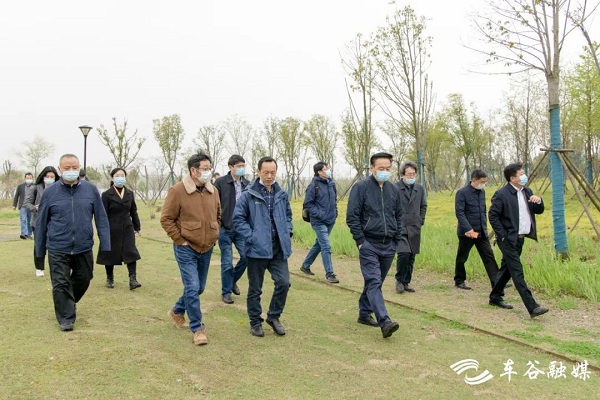

Experts and scholars visit Junshan New City in WEDZ on March 19. [Photo provided to en.whfkq.gov.cn]
Experts and professors from Huazhong University of Science and Technology, Wuhan University, Hubei University, and the Wuhan Municipal Institute of Archaeology were invited on research trips to Dajun Mountain, Xiaojun Mountain, and Shamao Mountain, all administered by the Wuhan Economic & Technological Development Zone (WEDZ), on March 19 to ascertain the historical origins of Junshan New City and its connection with the Battle of Chibi, which was a major naval battle fought on the Yangtze River between the allied fleet of Sun Quan and Liu Bei and the vast armada of Cao Cao during the Three Kingdoms period (220-280).
In The Commentary on the Water Classic (also known as Shui Jing Zhu in Chinese) – a work of Chinese geography in ancient times – the author described the geographical location of Dajun Mountain and Xiaojun Mountain, matching with their descriptions in The Records of the Three Kingdoms (also known as San Guo Zhi in Chinese), which is considered an encyclopedia on everything related to the Three Kingdoms.
The period was a vital stage for the development of the city of Wuhan. Wang Ran, a professor at the School of History of Wuhan University, said he believes that the site of the ancient battle was vast, including not only Junshan area and Hannan district, but also Xintan town and Jiangxia district.
"Wuhan has many cultural relics produced during the Three Kingdoms period, and many places, such as Zhuodao Spring and Wusheng Road, appeared in widespread stories during that period," said Zeng Yurong, a history professor from Hubei University.
The Wuhan Municipal Institute of Archaeology has unearthed many precious stoneware, earthware, and bronze ware ranging from the Neolithic Age – defined in China as between 10,000 to 4,000 years ago – to the Warring States Period (475-221 BC).